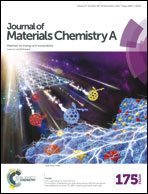A three-dimensional graphitic carbon nitride belt network for enhanced visible light photocatalytic hydrogen evolution†
Abstract
Three-dimensional (3D) network-like graphitic carbon nitride nanobelts (g-C3N4 NBs) were facilely achieved by the hydrothermal treatment of bulk g-C3N4 in a medium strong oxalic acid solution (1 M, pH 0.89). The positions of the conduction band (CB) and valence band (VB) were upraised from −0.90 and +1.86 eV for bulk g-C3N4 to −0.92 and +1.92 eV for g-C3N4 NB networks with enhanced redox ability, respectively. With an optimized Pt loading of 3%, the g-C3N4 NB networks showed excellent visible-light photocatalytic H2 production activity (1360 μmol g−1 h−1), which was 10.9 times higher than that of optimized 2% Pt@bulk g-C3N4 (124.7 μmol g−1 h−1) using triethanolamine as a sacrificial agent. Furthermore, Pt@g-C3N4 NBs exhibited a considerable rate of H2 evolution of 33.3 μmol g−1 h−1, much higher than 1.79 μmol g−1 h−1 for Pt@bulk g-C3N4 in distilled water without any sacrificial agents, revealing a great potential for photocatalytic overall water splitting. This outstanding performance not only originates from its unique 3D nanostructure and prolonged electron lifetime, but also from the electronic structure modulation and improved redox capacities of the CB and VB. The pH effect of hydrothermal conditions on the g-C3N4 molecular structure, chemical elements, optical properties and catalytic performance is also expounded. This study demonstrates a facile and environmentally friendly strategy to design highly efficient g-C3N4 catalysts for potential applications in solar energy driven photocatalytic water splitting.


 Please wait while we load your content...
Please wait while we load your content...